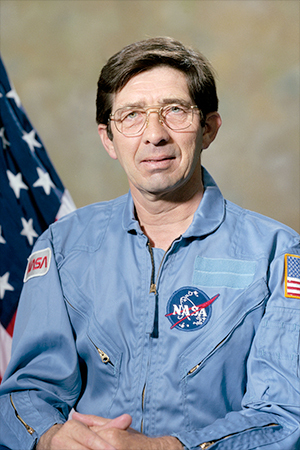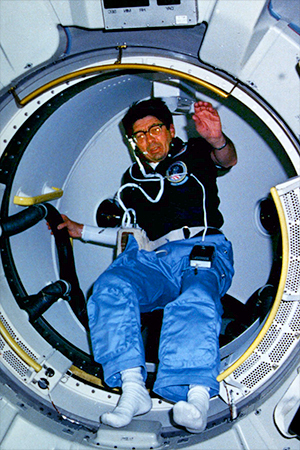21.10.2022


Lodewijk van den Berg, who studied crystal growth aboard the space shuttle Challenger as the first Dutch-born astronaut, has died at the age of 90.
Van den Berg's death on Sunday (Oct. 16) was reported online by the Association of Space Explorers, the professional organization for astronauts and cosmonauts.
Van den Berg did not set out to be an astronaut. Then a 53-year-old chemical engineer, his path into space came as a result of NASA inviting commercial and research organizations to fly experiments aboard the space shuttle. Specifically, NASA was preparing to fly the Vapor Crystal Growth System, a payload designed by van den Berg and his colleagues at EG&G Energy Measurements of Goleta, California, to advance the preparation of crystalline materials.
The 137-hour experiment, which involved the growth of a mercuric iodide crystal, required that someone monitor the crystal's progress from on board the shuttle.
"NASA decided at some point that it was more cost effective to train a scientist [who] knows the ins and outs of crystal growth to become an astronaut then it is to take an astronaut and try to train that person in all the classical science and so on," said van den Berg in a 2011 TEDx Talk delivered in the western Netherlands city of Delft.
NASA solicited EG&G for a list of candidates to fly with the experiment. Somewhat as a joke, the lab's chief added van den Berg to the list.
"NASA comes and says, 'Are you interested in doing that?' And in the beginning, you say, 'Oh, why not?' Let me put in my hat in with the group that they are going to select from [but] I am so old and I have bad eyes and so with this or the first selection step, I'm out," said van den Berg. "At least it makes a good impression on NASA that I'm interested."
Only van den Berg was not eliminated. Even after undergoing a very thorough physical exam, he was still in the running and ultimately became NASA's prime choice to fly as a payload specialist.
On April 29, 1985, van den Berg lifted off as a member of the STS-51B crew flying on the space shuttle Challenger. The flight marked the first launch of a fully-operational Spacelab science module as provided by the European Space Agency (ESA) and the seven-person crew split into two shifts to work around the clock.
Van den Berg was a member of the "Silver" team, working alongside mission specialist Norm Thagard and pilot Fred Gregory. The "Gold" team, who took over as van den Berg and his team mates slept, included mission specialists Don Lindand Bill Thornton, payload specialist Taylor Wang and commander Bob Overmyer.
Eager to see the effects that microgravity had on crystal growth, van den Berg was able to put aside whatever concerns he had of launching on the shuttle.
"You get seated on top of a big rocket with about two and a half million kilograms [5.5 million lbs] of high explosives and then you turn around and you tell the people on the ground, 'Fire it up,'" he told the audience in Delft. "How come that such an irrational decision, which anybody in their right mind would say you never want to do something like that, how do you still say, yes, I would like to do that?"
"The wish to be participating in this overrides the step that says I could lose my life or whatever else, maybe a finger," he said with a laugh.
Van den Berg's work on Spacelab focused on the growth of a mercuric iodide crystal, which on Earth is used in the fabrication of sensors to detect X-ray and gamma ray radiation for medical applications, the defense industry and for the International Atomic Energy Agency. After studying the space-grown crystal, van den Berg found that its stability and structural quality was superior to ground-based crystals.
STS-51B was van den Berg's only mission. Landing at Edwards Air Force Base in California on May 6, 1985, he and his crewmates logged 7 days and 8 minutes in space while completing 110 Earth orbits.
Van den Berg was born on March 24, 1932, in Sluiskil, Netherlands. He received his master of science in chemical engineering from Delft University of Technology in 1961. He then attended the University of Delaware, where he earned a master of science in applied science in 1972 and a doctorate in applied science in 1975.
After earning his Ph.D., van den Berg joined EG&G. As a defense contractor for the U.S. government, the company required van den Berg become a naturalized U.S. citizen. (Hence, the first Dutch citizen to fly into space was Wubbo Ockels, who launched six months after van den Berg.)
Following his return to Earth, van den Berg resumed his work at EG&G, becoming the lead for its material science division. Later, he moved to Florida to become the chief scientist at Constellation Technology, continuing his work in growing crystals.
Van den Berg's experience in space was the focus of "The 'Forgotten Astronaut'" (De 'Vergeten Astronaut'), a short documentary released in 2004.
Lodewijk College, a school in Terneuzen, The Netherlands, is named in his honor. In 2007, van den Berg also became the namesake for a main belt asteroid, 11430 Lodewijkberg, which was first found in 1960.
Van den Berg married Jacqueline Marvel in 1968. Together they had two children, Patricia and Christopher.
Quelle: CS
